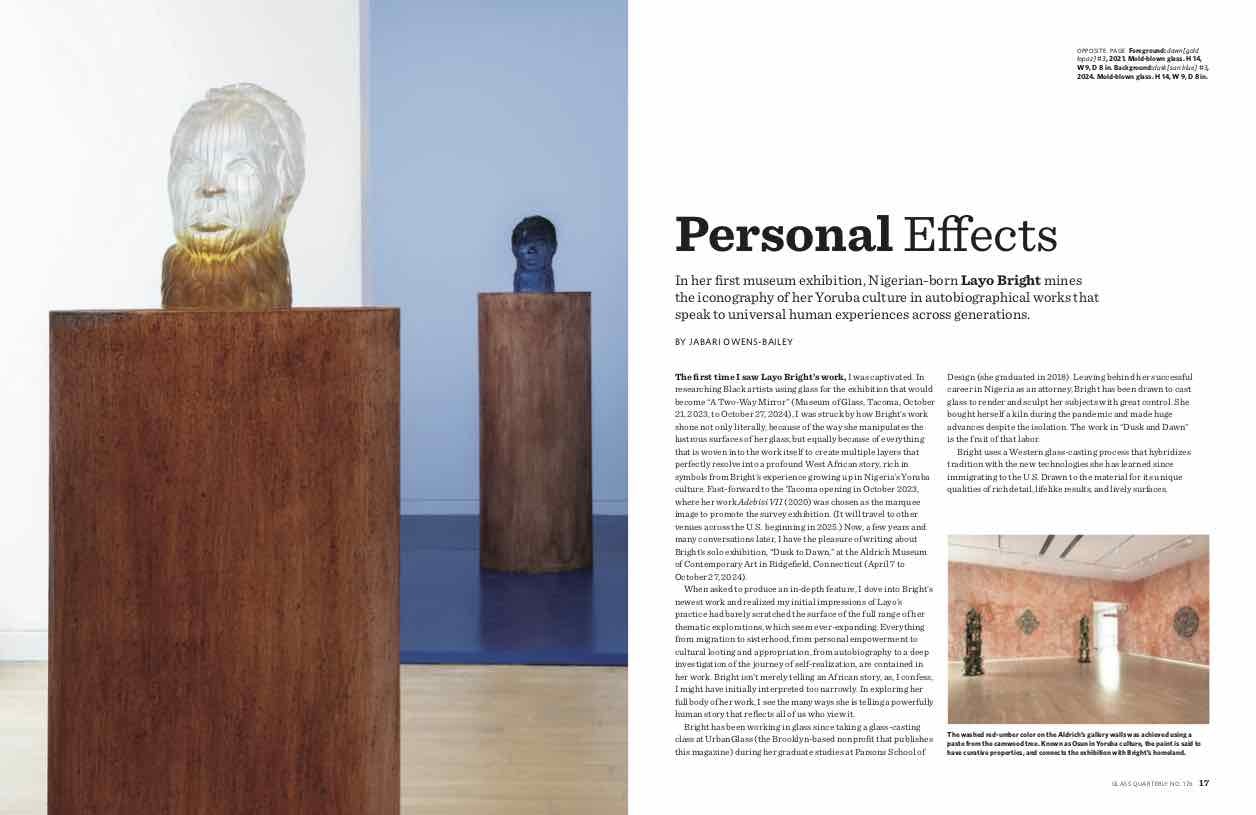The Fall edition of Glass (#176), bundled with New Glass Review (#44) and adorned by a striking work by Layo Bright on its cover, is on its way to subscriber mailboxes and select retail outlets. A native of Nigeria, Bright left her career as a laywer behind when she moved to the U.S. to study fine art at the School of the Visual Arts in New York City. It was here she discovered glass through a class she took at UrbanGlass (the arts nonprofit that publishes Glass), and she had found a key material to work with in her multi-media art practice, which curator and critic Jabari Owens-Bailey explores in an in-depth feature.

In the cover artwork, titled Bloom in Spring Green & Purple (2023), Bright presents the face of a woman engulfed in colorful flowers, detailed copies of actual species from both her native Nigeria and new home in the U.S. Like her flower arrangements, Bright’s work bridges the personal and the universal and reflects a cross-pollination of African and American cultures.

Now in his 80s, Peter Layton and the gallery and studio he has operated since the 1970s in the British capital city have sustained over the rise and potential fall (see “Saving the National Glass Centre” in the Summer 2024 edition, Glass #175) of glass art in the U.K. As the arts across Britain reel from funding cuts after leaving the E.U., Layton’s long-running apprenticeship program is more necessary than ever, and London Glassblowing gives up-and-coming glass artists a way to earn money as they develop their skills, providing them a place to develop their own young art practices in the process.

Lonnie Holley, a self-taught found-object artist who has become a major figure in American art, is the subject of a profile by Glass contributing editor John Drury, who co-taught a Pilchuck course with Holley in the summer of 2023. Drury, who has known Holley for decades, was carefully taking notes and marveling at Holley’s ability to dive into an entirely new medium without hesitation. Holley’s resilience is legendary, having overcome grueling setbacks in his impoverished childhood, and his success is a testament to the power of art to connect across great distances, be they geographic, social, or economic.

Also in this issue, Glass contributing editor Samantha De Tillio reflects on the ethereal work of Chinese artist Jinya Zhao, a graduate student at the Royal College of Art in London, who has already attracted major gallery representation for work that captures the ephemeral state of being in between.

As the final feature, Alicia Eggert’s neon word-art installations call attention to the passage of time, provoking viewers to contemplate matters sweepingly philosophical and political. To cover her first solo museum exhibition, Glass contributor Justin Ginsberg traveled across much of Texas to get to Beaumont. Ginsberg recounts his highly attuned experience, documenting and illuminating this important milestone in Eggert’s expansive career.
All this plus news and reviews, as well as a touching back page essay by April Surgent remembering her life-changing mentor Jiri Harcuba (1928-2013), who she credits with reviving a dying traditional technique by connecting it to contemporary artists.
Don't miss a single issue: Subscribe to Glass today.

NOTE: Subscribers will receive the latest edition of The Corning Museum of Glass exhibition-in-print New Glass Review bundled with their copy of the Fall 2024 edition of Glass. This is a longstanding partnership between two publications dedicated to identifying the most important new work being done in the medium of glass.



